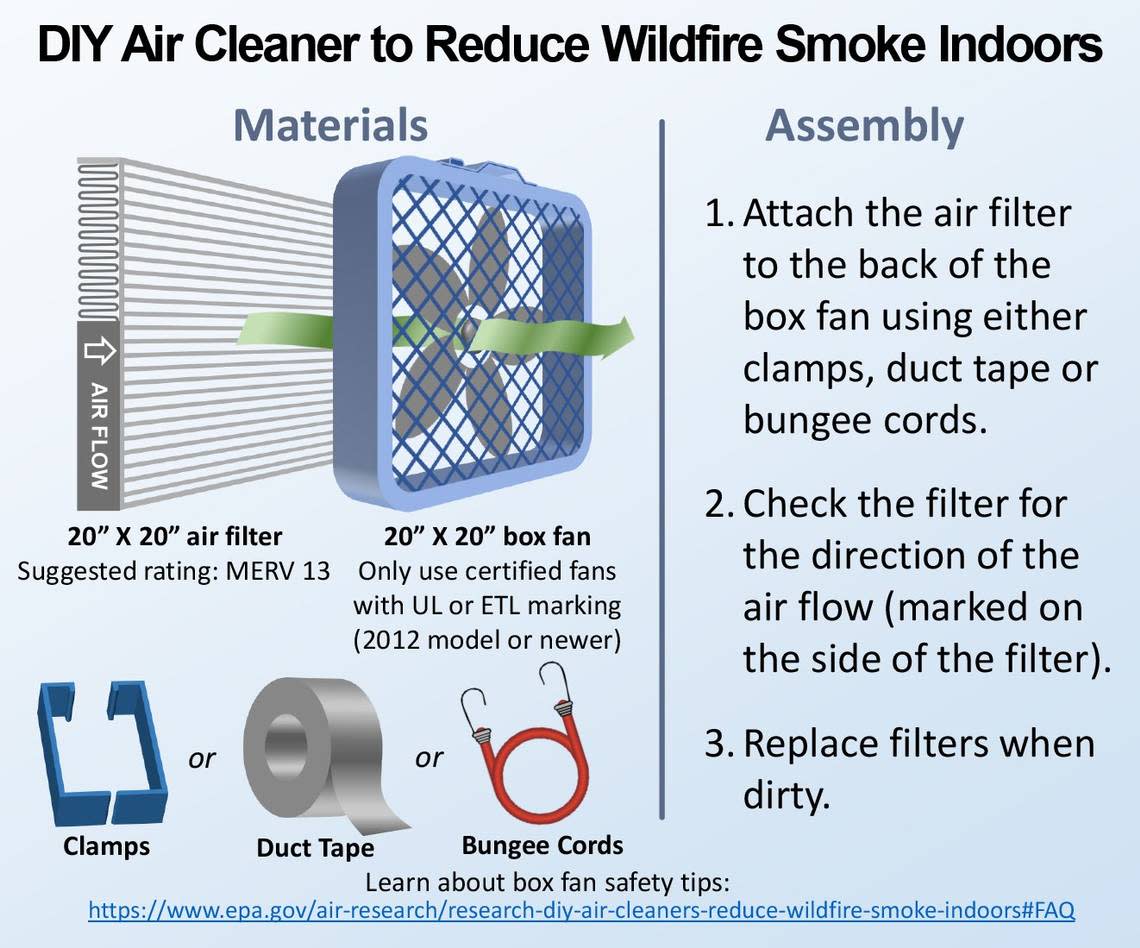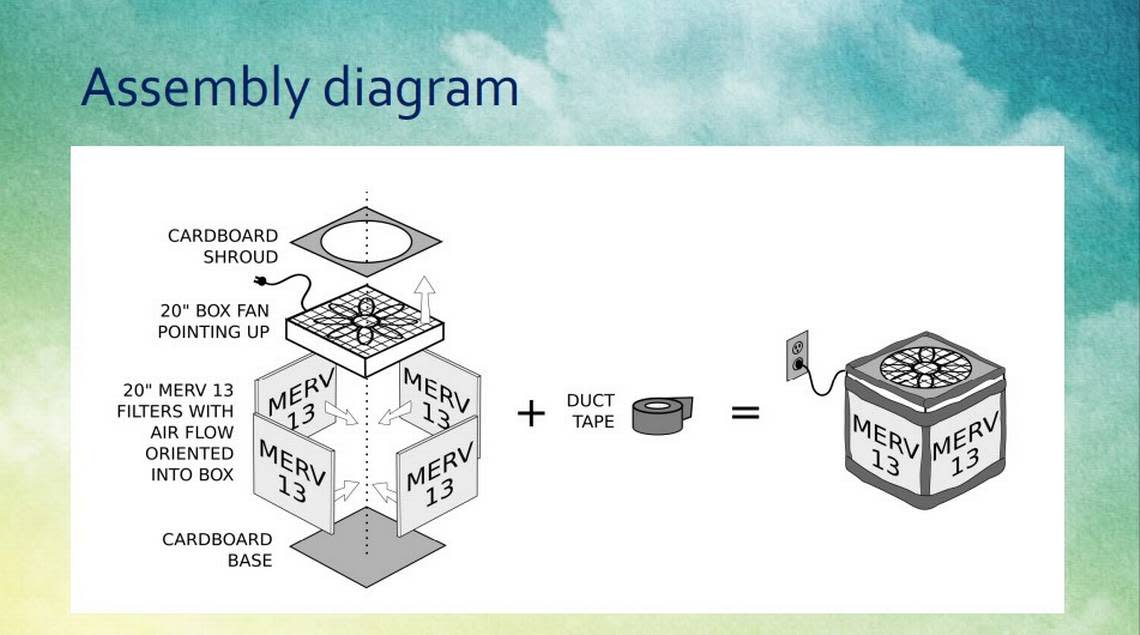Do DIY air filters work against California wildfire smoke? What to know about cost and safety
Do-it-yourself air filters are safe, effective and can be used to protect your lungs from California wildfire smoke.
Wildfire smoke is harmful and can stretch hundreds of miles. The smoke from the 2021 Dixie Fire in California was felt as far as Denver, The New York Times reported.
Here are two safe options, according to the University of California, Davis, the U.S. Environmental Protection Agency and the California Air Resources Board:
When should I use an air filter?
Good air filters can remove dangerous smoke particles from your home. According to the California Air Resources Board, indoor air cleaners help filter out small particulate matter that can cause health concerns.
Wildfire smoke produces harmful air pollutants that can aggravate existing health problems and increase the risk of heart attack or stroke.
The resource board recommends using a certified air cleaner whenever the air quality index is at an unhealthy level, which you can check at AirNow.gov. The agency also says if a board-certified commercial system is not an option for your home, a DIY is an OK alternative.
“These temporary air cleaners should be used with extreme caution, and only if other air cleaning options are unavailable,” the board writes on its website.
It says never leave the device unattended and only use box fans manufactured in the last 10 years (after 2012), as those fans “will have a fused plug, which will prevent electrical fires if the device is knocked over.”
Kinds of DIY air filters
Option 1
The EPA has tested a version of the DIY air filter with one MERV-13 filter flat against a box fan.
The agency outsourced in 2021 for Underwriters Laboratories Inc. to conduct a study on safety. The company found that covering the front and back of a 20-inch box fan for seven hours “did not pose any observable fire hazards.” When only covering the suction side of a 20-inch box fan, the surface would get hot, but not enough to cause a superficial burn.
The California Air Resources Board writes you should “close all windows and doors when the box fan filter is being used” and “change the air filter when it gets dirty.”
Option 2
Another design, known as Corsi-Rosenthal Box, does not have the air filter directly placed on the fan, but incorporates multiple filters and a cardboard bottom to create a cube. University of California, Davis researchers Richard Corsi, Theresa Pistochini, and others found it to be effective enough to combat airborne particles during the COVID-19 pandemic.
The EPA also lists this method as a low-cost way to protect yourself against wildfire smoke.
If you try this option, Pistochini told The Bee you should use the safety directions attached to the model of box fan you use.
How to build your own
The CR Box was “designed by experts but can be built by an amateur in under an hour,” NPR reported.
What you need for option 1, the filter fan, according to the EPA:
20-inch box fan
MERV-13 or higher AC/Furnace filters
Duct tape or bungee cord
At Walmart, for example, a box fan, filter and a roll of duct tape could cost roughly $50.

Check for an arrow or indicator on the filter to ensure proper air flow. Attach the filter to the suction side of the fan, the EPA instructs.
What you need for a CR box, according to the UC Davis study:
Duct tape
20-inch box fan
Two 20-by-20-inch pieces of cardboard
Scissors or a box cutter
4 MERV-13 or higher AC/Furnace filters
According to the state of Kentucky’s air quality division, its total cost is anywhere from $70-100.
The EPA suggests buying new box fans if you intend to do this project.

Construct the shroud for the fan out of cardboard, only the blades of the fan should be visible. Attach a shroud to the box fan. Tape all sides of the box together.
You can find detailed assembly instructions from the Kentucky’s Air Quality Division.
How much does it cost to buy an air filter?
The filters recommended by the EPA and creators of the Corsi-Rosenthal Box specify to use (20x20x1) MERV13 or higher air filters, which cost around $20 each at a hardware store. One or more of these materials are needed to build the DIY.
Home Depot: Elite Allergen Pleated MERV 13 Air Filter $20.97
Walmart: MERV13 air filters from Filtrete Brand $24.86
Amazon: Aerostar 20x20x1 MERV 13 Pleated Air Filter 4 pack $42.99, $10.75 per unit
Air resource board-certified filters, according to a UC Davis comparison of HEPA filters tested by UL, large-room models can range from $99 for the Whirlpool Whispure WPT60P to $899 for the ORANSI EJ120.
Are DIY air filters safe?
The EPA hazard findings for the use of a 20-inch box fan is comparable to the CR Box model. The fan in this model is not directly obstructed. Pistochini, with UC Davis, told The Bee the fan in a CR Box is more stable than the single filter option since the shape reduces the resistance and protects it from falling over.
She uses the model around her own children, and does not think it is any more dangerous than other electrical appliances found in the home, she said. The box is cost efficient and effective, but she and the EPA recommend people buy UL tested HEPA filters as a long-term solution. Underwriters Laboratories, UL, is a OSHA-certified electrical testing facility that mitigates risk, injury, or danger, according to its website.
You should turn off the fan if it gets over heated or if you leave the house.
While HEPA filters are the more quality option for an air filter, using a MERV-13 furnace version will still collect particle concentrations, Corsi, Pistochini, and colleagues wrote in their report on the performance of the CR Box.
What do you want to know about life in Sacramento? Ask our California Utility Team your top-of-mind questions in the module below or email utilityteam@sacbee.com.
